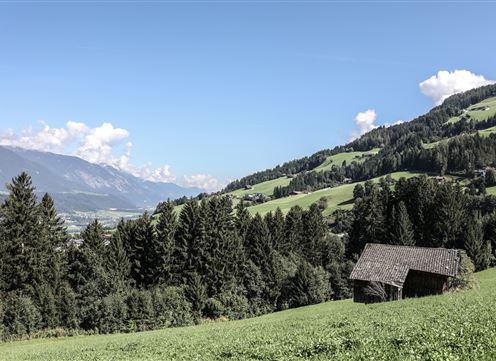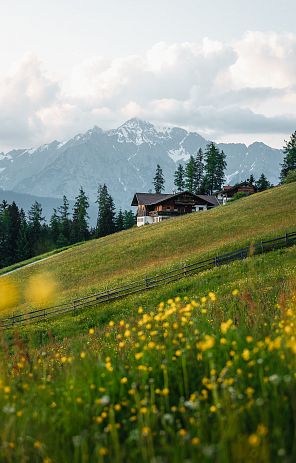Powerful Place. Himmelreich rhaetian settlement in Volders
When you visit the Rätersiedlung Himmelreich, you immediately realize why one of the first settlements in the Inn Valley was built here of all places. There were certainly strategic considerations behind this decision, but the power of this place cannot be denied.
The Rätersiedlung Himmelreich is located on a hilltop between Wattens and Volders and is on the historical circular hiking trail. Himmelreich can be reached within half an hour from both Wattens and Volders. A small fitness trail and a viewing platform make our place of power a place of encounter, but also of peace and reflection on the lives of our ancestors. The power place Rätersiedlung Himmelreich enables us to search for home, for history, for identity and for where to go.
The Himmelreich power place at a glance
- Karlskirche Volders
- Friedberg Castle & Aschach
- Wattens Municipal Museum
- Dr. Karl Stainer - Discoverer of Himmelreich
- Historical circular hiking trail
The history of the Rätersiedlung
Many moraine hills and rocky outcrops in Tyrol were covered by farmsteads and settlements, some of which were fortified, during the last centuries BC.
The settlement on the 'Himmelreich', a quartz phyllite ridge between Volders and Wattens, which has advanced towards the Inn Valley and was investigated by Dr. Alfons Kasseroler between 1953 and 1955, is the most impressive of those excavated in Tyrol to date. Various buildings belonging to a stand-alone fortified manor stood on the uppermost hilltop. Their ground plans are chiseled out of the bedrock, the rising parts were originally built of wood using the block construction technique. A fortification wall raised with a palisade protected the castle-like farmstead, which was built in the 5th/4th century BC. In addition to the residential and farm buildings, there was a unique feature within the courtyard area: a rainwater cistern carved 10.4 m deep into the quartz phyllite in two stages.
The majority of the finds (exhibited in the museum) come from houses I and V. Both buildings were two-storey hillside houses, at least in a more recent period of the settlement period, while house V had two rooms at ground level.
To the east and north of this hilltop was a slightly lower terrace, which was almost completely removed by the ongoing work in a quarry. It was probably the site of a burnt offering, which could not be archaeologically investigated.
Between 1932 and 1948, Dr. Karl Stainer collected extensive finds in this area, which could confirm the theory of a burnt offering site (4th century BC to 4th century AD).
Around this time, the village was destroyed in the course of the Roman conquest. Subsequently, the ruins apparently only served as a temporary shelter or hiding place (see coin finds from the 1st to 4th century AD). The Roman finds from the terrace settlement prove at least a limited revival of settlement activity there.
(c) Local history and museum association Wattens-Volders
The Himmelreich open-air museum
The foundations of eight buildings, some of which are carved into the rock, can be found in the former settlement area enclosed by a ring wall. The Rhaetian settlement was inhabited between the 5th and 1st centuries BC and was destroyed by fire.
The Rhaetian settlement at Himmelreich was badly affected by severe storms at the beginning of this century. Fallen and uprooted trees partially destroyed the towering walls and the rampart. An infestation of balsam overgrowing the entire hill did the rest.
Triggered by a diploma thesis by the young architect Daniela Egger on the Rhaetian Himmelreich settlement, the Wattens-Volders local history and museum association decided in 2009 not only to carry out a thorough restoration, but also to make the assumed cubature of the Rhaetian houses visible and to provide comprehensive information on the conditions under which people lived here. On display are Rhaetian houses with the typical floor plan: carved out of the rock with an angled entrance and two doors. The cubatures of all the Rhaetian houses are marked by a frame made of rusted steel. The glass panels in the area provide brief information on the history of this memorable place.
Medical Councillor Dr. Karl Stainer
The community doctor Dr. Karl Stainer (born 1868 in Innsbruck - died 1949 in Wattens) took over the district doctor's post in Wattens on 1 April 1894. He was the son of the famous Geierwally (Anna Stainer-Knittel). Dr. Karl Stainer knew the worries and hardships of the little people. During the famine in the First World War, he tried out all kinds of fruits of the wild and taught women how to use them. He set up a Red Cross station, improved the infrastructure and planned healthy housing in 1936 to prevent the dreaded diseases of the time. The doctor requested clear spring water from the municipality for the population. In 1908, he founded the "Gemeinnütziger Verein" (charitable association), which was committed to social causes and the beautification of the community for 30 years. The annual association newspaper was the first information newspaper in the municipality of Wattens. Although suffering badly in his old age, he devoted himself to his medical commitments to the very end. For his services, Stainer was awarded the professional title of Medical Councillor.
Around 1920, he made the important archaeological discovery of the Himmelreich council settlement. During quarry work north of the hilltop, prehistoric artifacts came to light. In addition to important finds for Tyrolean numismatics (including Vindelik gold staters), he also discovered the late Hallstatt to early Latène period settlement to the north of Fritzens, after whose finds Gero v. Merhart coined the term "Fritzner Keramik". Stainer managed the finds and supported the archaeological research there. The finds of weapons, tools, ceramics and coins were handed over to the Tyrolean State Museum Ferdinandeum by Dr. Stainer during his lifetime. Today they form a significant part of the museum's prehistoric collection.
Local history and museum association Wattens-Volders
After Dr. Karl Stainer, Dr. Alfons Kasseroler is also an important figure in connection with the Himmelreich council settlement. He made further discoveries, including the urn field of Volders. It was his wish to preserve it and make it accessible to the public in a small museum.
In 1965, in close cooperation with Kasseroler, the then principal of the secondary school, Konrad Fichtl, founded the Wattens-Volders local history and museum association for this purpose. Its statutory objectives are
- the promotion of scientific research into the local area, its nature, history, economy, art and culture,
- the conservation and preservation of historical excavation sites as well as cultural and natural monuments,
- the management of the Wattens Museum, which is divided into two sections: 'Prehistory and Early History' and the 'Development History of the Swarovski and Wattens Paper Mill Companies'
- the management of a local history library and the publication of local history publications.
Wattens Museum
The municipality of Wattens opened a new museum in the town center on 5 October 2018. Some of the archaeological finds from the region and the Rätersiedlung settlement can be seen there. Other finds are professionally stored in the depot of the new Museum Wattens. The Museum Wattens is an institution of the market town of Wattens and works together with various local associations, universities and research institutions. The museum is a lively venue for events and, with its tourist information center, a place for locals and visitors alike.
Fritzens-Sanzeno culture
The Fritzens-Sanzeno culture formed north and south of the main Alpine ridge in the decades around 500 BC.
The Fritzens-Sanzeno culture is an archaeological cultural group of the Iron Age or La Tène period in the area of the Alps. Early finds at Fritzens and at Sanzeno on the Nonsberg (Trento) gave the cultural epoch the name Fritzens-Sanzeno culture. Its bearers, identified as Rhaetians, were completely wiped out or permanently Romanized during the Roman campaigns in the Alps and their foothills in 15 BC.
The historical circular hiking trail
Our place of power is located directly on the historic circular hiking trail between Volders and Wattens. The exact route is described in the next section (Hikes). As the name suggests, you will find a lot of historical background on this hike. Among other things, you pass the famous Karlskirche church and two castles, Friedberg and Aschach. Chapels and churches round off the offer on this trail. Here is a brief description of the individual stops:
The legend "Salige Frauen am Himmelreich"
In the course of his research, Dr. Karl Stainer spoke to the Moar farmer from Volders, who told him about a legendary cave on the western Himmelbergschrofen, which was probably destroyed when the "Am Himmelreich" quarry was built.
Salige, by the way, means wise
There was once a gap in the steep ridge of the Himmelreich, which is now used as a quarry, and it is said that two salty ladies lived there. The two were very popular with the inhabitants of the surrounding area because they were hard-working and skillful and helped with work in the house and fields wherever necessary. One day, a farmer's daughter from Wattenberg passed by Himmelreichschrofen. One of the Saligen stood outside the cave, called the woman and asked her to pass on a message to her companion, who was working on the Wattenberg: "You, Imsel, the blackbird has died!" The farmer's daughter delivered the message and Imsel cried out, packed up her things and disappeared. Since then, no one has ever seen the two little ladies again.
Christine Zucchelli - Mysterious Hall






